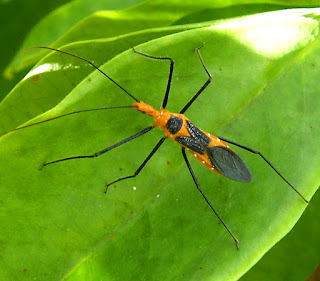Florida Nature Pictures
The Milkweed Assassin Bug (Zelus longipes Linnaeus) is a beneficial insect that helps to control populations of pests in Florida gardens. They are not aggressive and do not pose a threat to humans or pets. Unfortunately, these bugs are also predators of caterpillars, including those of the monarch butterfly. They are also known to feed on other insects, such as aphids, leafhoppers, and beetles.
Milkweed assassin bugs are slender, brown insects with long antennae. They are about 1 inch long and have a distinctive needle like proboscis which it keeps folded under its head.. This piercing mouthpart is not used to inject venom, but to inject digestive enzymes into their prey. They are sometimes confused with Milkweed Bugs (Micracanthops floridanus). Assassin bugs have longer more slender heads and the piercing mouthpart that the Milkweed Bugs do not.

Here are some additional facts about the milkweed assassin bug:
- They are solitary insects and do not form colonies.
- They are active during the day and can be seen hunting for prey on milkweed plants and other vegetation.
- The female milkweed assassin bug lays her eggs in clusters on milkweed plants. The eggs hatch into nymphs, which resemble miniature adults.
- The nymphs go through several stages of development before they become adults.
- The milkweed assassin bug has a lifespan of about one year.










